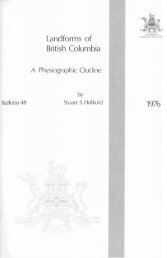Sustainable Food Production, Consumption, and the Generation of
Sustainable Food Production, Consumption, and the Generation of
Sustainable Food Production, Consumption, and the Generation of
Create successful ePaper yourself
Turn your PDF publications into a flip-book with our unique Google optimized e-Paper software.
3. What are <strong>the</strong> policies in place to implement sustainable food chain issues <strong>and</strong> what are <strong>the</strong>ir<br />
limitations?<br />
The research was conducted in May 2005 in <strong>the</strong> Capital District Region <strong>of</strong> Victoria. After <strong>the</strong><br />
conclusion <strong>of</strong> <strong>the</strong> research <strong>and</strong> <strong>the</strong> editorial process, <strong>the</strong> students presented <strong>the</strong>ir findings during a<br />
seminar at UVIC, open to <strong>the</strong> general public. I herewith want to thank everybody who has<br />
collaborated with this study <strong>and</strong> would like to reiterate <strong>the</strong> importance <strong>of</strong> <strong>the</strong> University reaching<br />
out to <strong>the</strong> community by conducting local studies <strong>and</strong> disseminating <strong>the</strong> findings.<br />
1.2 Questionnaire design<br />
The design <strong>of</strong> <strong>the</strong> questionnaire for all three sections; local production, consumption <strong>and</strong><br />
packaging waste; was based primarily on previous qualitative research found in <strong>the</strong> literature on<br />
each specific topic, <strong>and</strong> drew heavily from <strong>the</strong> overall objectives <strong>of</strong> <strong>the</strong> group research project. A<br />
combination <strong>of</strong> open <strong>and</strong> close-ended questions were developed for each section <strong>of</strong> <strong>the</strong><br />
questionnaire <strong>and</strong> compiled into a three-page survey, each consisting <strong>of</strong> between 10-15 questions<br />
(see Appendix A for sample <strong>of</strong> questionnaire). A pre-test was applied to <strong>the</strong> questionnaire to<br />
determine <strong>the</strong> variance <strong>and</strong> clarity <strong>of</strong> <strong>the</strong> questions, <strong>and</strong> later revised based on this input. The<br />
length <strong>of</strong> <strong>the</strong> questionnaire was influenced by <strong>the</strong> time duration required from each respondent,<br />
which was approximately 10 minutes.<br />
1.3 Questionnaire administration<br />
The questionnaires were administered at four different food retailers in <strong>the</strong> CRD. The<br />
retailers were located in four distinctive areas: a mid-scale store in a downtown location, a smallscale<br />
store suburban location with a large seniors population, a mid to large-scale store in a<br />
higher income suburban area, <strong>and</strong> a small-scale year-round farmers market on <strong>the</strong> rural-urban<br />
fringe. The administration <strong>of</strong> <strong>the</strong> questionnaire was timed such that data would be collected in<br />
<strong>the</strong> morning, afternoon <strong>and</strong> evening at each location during weekdays. No demographic<br />
information was collected however information on <strong>the</strong> gender <strong>and</strong> approximate age <strong>of</strong> each<br />
participant was noted after <strong>the</strong>ir completion <strong>of</strong> <strong>the</strong> questionnaire. At one location five-dollar gift<br />
cards were given after completion <strong>of</strong> <strong>the</strong> survey for use inside <strong>the</strong> grocery store.<br />
1.4 Questionnaire analysis<br />
6











